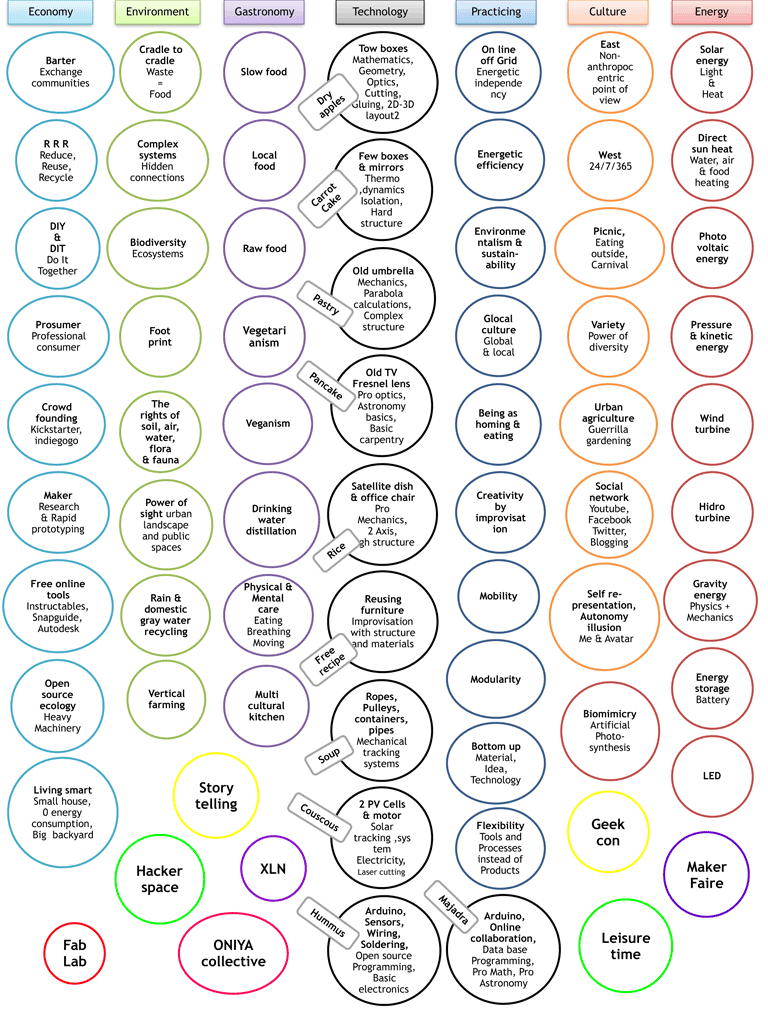Week 17:
Applications and Implications
Focusing on the final project by answering on following questions:
What will it do?
It will follow the sun and cook food on solar heat.
How will it do?
It will have 1m diameter 0.25m depth parabolic mirror to focus the sun light on the cooking pot.
It will rotate the parabolic mirror up and down, left and right with two motors.
The rotation of the mirror will be according 4 light sensors which calibration will track the light source direction. Each sensor will be spinted in different EAST,WEST,SOUTH and NORTH directions on the mirror. Each sensor will represent different direction of motion. At the moment that sun changes position there will be more shadow on one or two sensors than on the rest of them. The motors will fix the position by moving the mirror toward the sun until the light spreads equally between the sensors.
What materials and components will be required?
Optics:Parabolic mirror - abs, mylar.
Thermo:Grill on sun altitude axis rod - metal.
Mechanics:Base Construction with two turnable axises
Plywood press-fit kit
Bearings
1 Micro controller ATTiny 44
1 On/off button
4 phototransistors
2 Steppers/servos
1 On/off button
1 Diode
2 Leds
1 Mosfet
3 Capasitors
7 Resistors
1 Resonator
1 Regulator
1 Two 2*3 pins headers
1 FTDI 6 pins
1 Power Jack
Optional:
Temperature sensor
PV panel
Battery
Wifi network and aplication
Where will they come from?
Mostly from local suppliersHow much will it cost?
Around 170$:
Electronics and wiring: 10$PVC vacuum forming: 30$
Mylar film: 10$
Silicone: 10$
Plywood structure: 50$
Metal grill and rod: 20$
Bearings 10$
Motors: 30$
What parts and systems will be made?
Most of them except of the motors, bearings, battery and PV cell.What processes will be used?
Electronics production PCB milling, soldering, wireing
Vacuum forming for parabolic shape
Vinyl cutter for mylar cutting
CNC for the molds and the rigid structure
Laser cutter for gears and dish support
Molding and casting for parabolic dish details
What tasks need to be completed?
Design:
Turnable elements
Motion system
Electronic board
Fabricate:
Laser-cut Gears and dish support
Vinyl cut 2D layout of the mylar cover
Vacuum form the dish slices
Cast more of the dish slices joint elements
Create the PCB board layout, mill and stuff it
Wright the code, compile inputs and outputs
What questions need to be answered?
How can parabolic dish move on two axises around the focal point?
If I use PV panel and battery to make it Autonomous during the day how can it be converted at night into wifi/radio signal amplifier?
What is the schedule?
3 day for CNC molds and structure fabrication1 day for vacuum forming mylar cutting
2 days for silicone casting
1 day for mechanical motion tests
1 day for electronics production
2 days for programming and debugging.
How will it be evaluated?
Let us see soon…
First of all it there is necessarily need to make the proof of concept by combining the input of the phototransistors with the output of the motors, even if it will be done in small scale. I’m actually trying to design my own mechanical motion system for that.
I am also pushing the production of full scale parabolic mirror to be ready for the presentation.
Second level of the spiral development would be to add PV panel power supply and thermo sensor to make the cooker autonomous and with programable interface application.
Third level would be to convert the device from cooking to solar energy harvesting by adding modularity and fitting connections between the different parts of the system in same pattern.
Forth level can be parametric press fit kit that will encourage reusing local materials instead using the raw ones.
Fifth could be conversion of the system in to heliostat by changing the program and mirror with flat one.
Sixth could be conversion of the cooker in to wifi receiver/transmitter amplifier.
